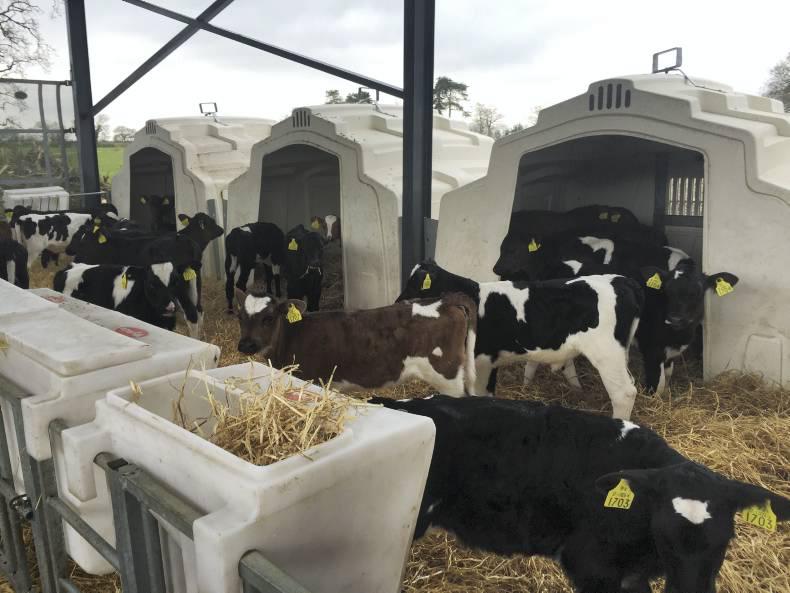Many of the causes of calf health problems can be traced back to housing. Draughts, wrong temperature and stale air are all causes of pneumonia and other diseases.
Really, calf housing should mimic what happens in nature – look at young suckler calves out in a field with their dams: A good cow will lie in a dry, sheltered spot and the calf will be tucked up beside her, sheltered from any breeze. If the wind changes, the cow will move to keep the calf sheltered.
The cow’s body temperature, at 37°C, acts like a radiator – increasing the heat available to the calf on cold days, while on warmer days, the calf can lie on its own.
When we look at calf housing on farms, it tends to fall into two categories – either old stone sheds that are useful for nothing else now but calves, or newer, larger steel sheds that are easier to clean out. Neither type of shed is designed solely with the calf’s needs in mind.
Having expanded his herd rapidly since getting into dairy cows in 2010, Sean Roberts needed new dedicated calf housing. The old sheds were labour-intensive and calves were getting sick.
Rearing
“The change from sucklers to dairying was grand. I could manage the calving, milking and grass fine, but the calf-rearing was a real challenge, especially when calves got sick, which happened every year.”
Sean purchased 16 calf hutches and this year he modified the layout, built a canopy shed and installed a computerised calf feeder to feed the calves.
He has 112 heifer calves in the hutches on his farm just outside Old Ross, Co Wexford.
Sean is calving down 350 cows this year, but plans to milk about 325. Once weaned, the calves will go straight to the contract rearer and come back as in-calf heifers. The bull calves stay in the old calf sheds until they are sold at two weeks of age.
There are four pens in the new calf shed, with 28 calves in each pen, and they have free access to four hutches. A feed station linked to the DeLaval feeder is in the corner of each pen. The hutches were bought locally from Enniscorthy Farm Services, but are imported from Canada by Teemore Engineering.
The first thing you notice when you walk into the shed is that it is extremely open and windy. You wouldn’t hang around there too long without wearing a jacket, even on a good day. There is a windbreaker on the southern gable which does take some of the sting out of the breeze.
The next thing you notice is how content the calves are. When I visited last week, about half of the calves were lying inside in the hutches, with the rest wandering about or lying outside the hutches. The oldest calves were born on 28 January, so average age in the shed is about five weeks old.
Sean says that when it is very cold, most of the calves will go into the hutches. There is a vent on top of the hutch to allow hot air out.
Unlike in a large shed, younger calves produce enough heat from within the hutch to push the hot air up and out, so the hutch is warmer for calves, but still isn’t stuffy.
Costs
The hutches cost €750 plus VAT each and an extra €250 plus VAT for three 8ft gates that go in the front of the hutches.
Sean used these gates to make the group pens in his shed. The gates are held together by steel posts placed in sleeves in the floor.
There is a one in 20 fall from the back of the hutch to a channel in the central passage and a 1 in 60 fall in the channel to a small tank at the end of the shed.
When it comes to cleaning out the shed at the end of the season, the penning will be dismantled, the hutches will be lifted away with the loader and the shed will cleaned out by the tractor.
The roof covers the area in front of the hutches with a 3ft overhang over the top of the hutches.
“I put up the roof to keep the front of the hutches and the area around the feeder dry. It’s a simple structure, but it does the job. Last year, before I built the roof, I was using a lot more bedding, as the straw kept getting wet whenever it rained,” Sean says.
The shed and the concrete floor cost €13,000. So the total cost of the calf house is €29,000. This doesn’t include the cost of the automatic calf feeder, which, depending on spec, will cost about €10,000 for a four-station machine capable of feeding 120 calves.
Sean is happy with the setup. The calves look well and are extremely healthy. He says the time saving alone is huge.
He beds the calves every second day and fills the milk replacer and checks up on the calf feeder twice a day.
Last year, Sean employed a full-time calf rearer up to the end of April, but this year the rearer finished up last week.
Comment
This calf shed isn’t necessarily a low-cost shed. A more conventional-type calf shed featured in the buildings page in February this year cost €45,000 to hold 90 calves, so it is lower-cost than some of the alternatives, but there are still cheaper ways of rearing calves, such as outdoors. The big question is – is it healthier for calves than a conventional shed?






 This is a subscriber-only article
This is a subscriber-only article
















SHARING OPTIONS: